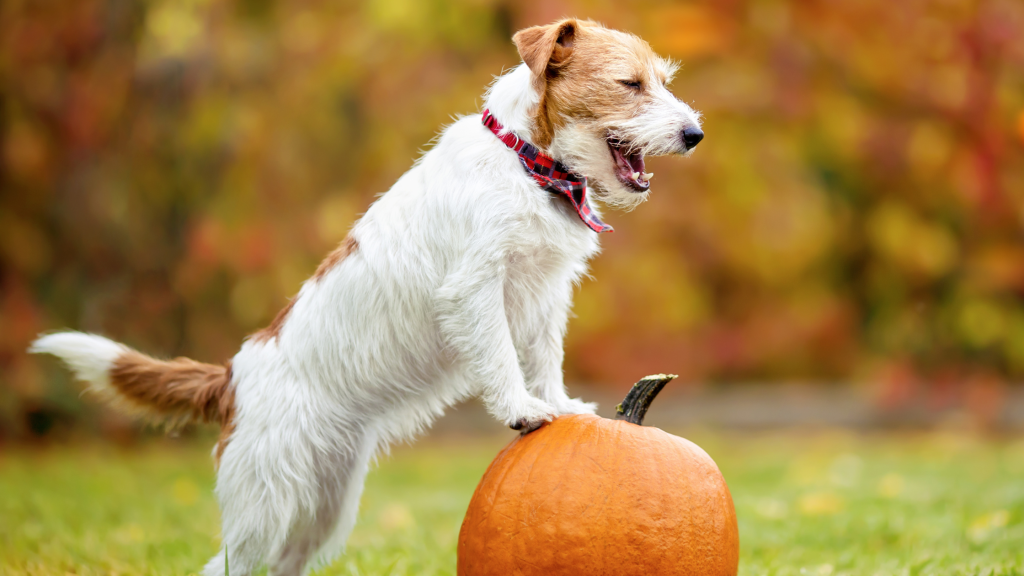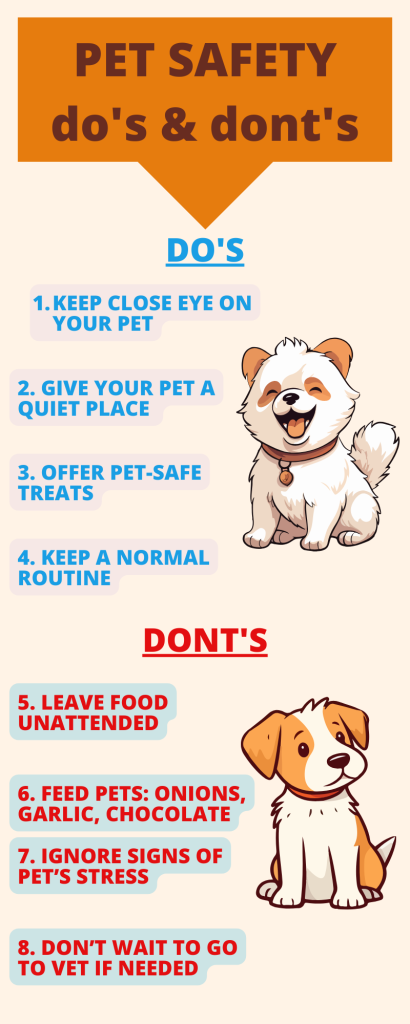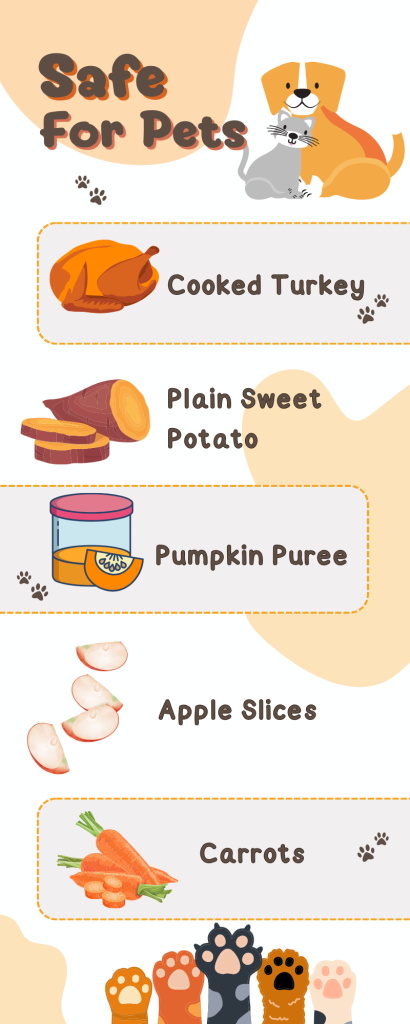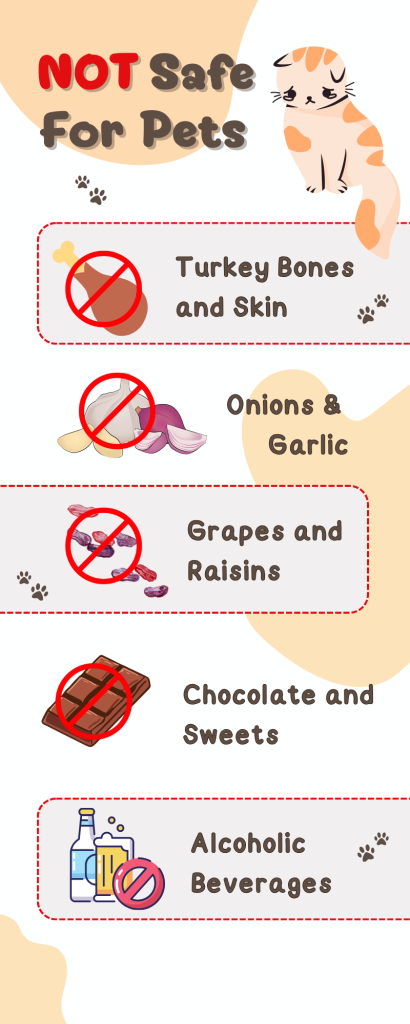
Thanksgiving is a time of joy, gratitude, and family gatherings. Amidst the bustling kitchen, the laughter around the dining table, and the warmth of loved ones, it’s essential to remember our furry family members. Pets, integral to our homes and hearts, also deserve a safe and joyful Thanksgiving. However, this festive season can pose several hazards to their well-being. From the tantalizing turkey left within reach to the bustling crowd of guests, our pets face numerous risks. This brings to light not only the need for vigilant pet safety but also the importance of a safety net—pet insurance. In this guide, we will explore how to navigate Thanksgiving safely with your pets and how pet insurance can provide peace of mind in the face of potential hazards.
Common Thanksgiving Hazards for Pets
Food Dangers
Thanksgiving is synonymous with a feast, but not all human foods are safe for pets. Here’s a breakdown of common Thanksgiving foods that can be toxic to your pets:
- Chocolate: Often used in desserts, chocolate contains theobromine and caffeine, which are toxic to dogs and cats.
- Onions and Garlic: These common ingredients can cause gastrointestinal irritation and could lead to red blood cell damage in pets.
- Grapes and Raisins: Even in small amounts, grapes and raisins can cause kidney failure in dogs.
- Alcohol: Alcohol is significantly more toxic to pets than to humans and can lead to vomiting, diarrhea, difficulty breathing, coma, or even death.
- Xylitol: This sweetener, found in some sugar-free baked goods, can cause insulin release and hypoglycemia in pets.
- Bones: Turkey bones can splinter and cause choking or serious damage to your pet’s digestive tract.
Being aware of these dangers is the first step in preventing a holiday emergency. Always ensure that these foods are kept out of your pet’s reach and educate your guests about the risks as well.
Decorations and Plants
Decorations add to the festive spirit but can be hazardous to curious pets. Small ornaments can be choking hazards, and strings of lights can pose a risk of entanglement or electric shock if chewed. Additionally, certain holiday plants like lilies, poinsettias, and holly berries are toxic to pets if ingested.
To ensure your pet’s safety, keep decorations out of reach and opt for pet-friendly decor. Be mindful of where you place plants and perhaps consider artificial alternatives that pose no risk to your pets.
Stress and Anxiety
Thanksgiving can be a hectic time, and not all pets cope well with changes in routine or the presence of unfamiliar guests. Signs of stress in pets include hiding, aggression, or changes in eating and bathroom habits.
To help your pet stay calm:
- Create a Quiet Space: Set up a quiet, comfortable area away from the noise where your pet can relax.
- Maintain Routine: Try to stick to your pet’s regular feeding and exercise schedule.
- Use Calming Aids: Consider pheromone diffusers or calming treats for pets prone to anxiety.
Preventative Measures
Safe Foods for Pets
While many traditional Thanksgiving foods are off-limits, you can still treat your pet to some holiday goodies. Safe options include plain, cooked turkey (without skin or bones), plain sweet potatoes, and pumpkin puree. Always introduce any new foods in small quantities to avoid gastrointestinal upset.
Creating a Safe Space
In addition to setting up a quiet space, ensure your home is pet-proofed:
- Secure trash cans to prevent pets from scavenging.
- Keep food and decorations out of reach.
- Use baby gates to restrict access to certain areas if necessary.
Supervision and Training
Supervising your pet during the festivities is crucial. If you’re unable to do so, consider keeping them in their safe space or using a pet sitter. Basic training commands like ‘leave it’ or ‘stay’ can also be helpful in preventing your pet from getting into dangerous situations.
Emergency Situations and First Aid
Recognizing Symptoms
Know the signs of distress or illness in your pet, which can include vomiting, diarrhea, lethargy, or sudden changes in behavior. If you notice any of these signs, contact your veterinarian immediately.
First Aid Basics
While first aid is not a substitute for veterinary care, it can be crucial in stabilizing your pet until you can get professional help. Keep a pet first aid kit handy and familiarize yourself with basic first aid procedures.
Emergency Contacts
Have the contact information for your regular veterinarian and the nearest emergency animal clinic readily available. Also, inform yourself about the process and cost of emergency care.
Navigating Pet Health Emergencies: The Value of Being Prepared
Unexpected Costs
Even with the best precautions, accidents can happen. Whether it’s an unintended nibble of chocolate or a curious paw caught in decorations, emergency vet visits can be unexpected and costly. The holiday season, with its unique set of risks, underscores the importance of being prepared for any eventuality.
Why Pet Insurance Matters
Having pet insurance is like having a safety net for such unforeseen incidents. It’s not just about covering costs; it’s about the peace of mind that comes with knowing you can provide the best care for your pet in a time of need. This insurance can cover a range of issues from minor accidents to major illnesses.
Choosing What’s Best for Your Pet
Every pet and every family is different. When considering pet insurance, it’s important to find a plan that aligns with your pet’s health needs and your financial situation. Look into the specifics of what each policy covers and consider factors like breed-specific conditions, deductibles, and coverage caps.
Reflecting on Pet Safety and Care
As we prepare for the festivities of Thanksgiving and welcome the joys of the season, it’s a fitting time to reflect on the well-being of our beloved pets. This reflection includes not only immediate safety measures but also long-term care considerations.
Think about the steps you can take today to ensure a safer tomorrow for your pet. Whether it’s updating your pet’s first aid kit, practicing emergency drills, or considering the role of pet insurance in your life, every action contributes to the health and happiness of your furry family member.
This Thanksgiving, let’s cherish and protect the bonds we share with our pets. By being mindful of their safety and prepared for their health needs, we strengthen the love and care we offer them every day.
Do’s and Don’ts for Pet Safety During Thanksgiving
Do:
- Do keep a close eye on your pets around Thanksgiving decorations and food.
- Do ensure your pet has a quiet place to retreat from the holiday hustle and bustle.
- Do keep your pet’s routine as normal as possible, including feeding and exercise times.
- Do offer pet-safe treats like plain, cooked turkey, carrots, or apples.
- Do ensure your pet is wearing identification, in case they escape amidst the comings and goings of guests.
Don’t:
- Don’t leave food unattended where pets can reach it.
- Don’t feed your pet Thanksgiving staples like onions, garlic, grapes, or chocolate.
- Don’t allow guests to feed your pet without your permission.
- Don’t ignore signs of stress or discomfort in your pet.
- Don’t delay in seeking veterinary help if you suspect your pet has eaten something toxic.

Safe vs. Unsafe Thanksgiving Items for Pets
Safe Items:
- Cooked Turkey (plain, boneless, skinless)
- Plain Sweet Potatoes
- Pumpkin Puree (not pie filling)
- Apple Slices (without seeds)
- Carrots (cooked or raw)

Unsafe Items:
- Turkey Bones and Skin
- Onions and Garlic
- Grapes and Raisins
- Chocolate and Sweets, especially those containing Xylitol
- Alcoholic Beverages
Pet Parent Experiences

Sarah’s Story:

“Last Thanksgiving was a nightmare! I accidentally left some grapes on the coffee table, and our Beagle, Max, got into them. He started vomiting, and I panicked. Thankfully, we had pet insurance. The emergency vet bill was over $1,000, but our insurance covered most of it. I don’t know what we would’ve done without it. Now, I’m super careful about what’s within Max’s reach.”
Mike’s Testimonial:
“I remember how our cat, Whiskers, freaked out last Thanksgiving with all the guests and noise. She hid and wouldn’t come out. We thought she was just scared, but later found she’d hurt her paw. Rushed her to the vet, and man, was I glad we had pet insurance then. It gave us one less thing to worry about in that stressful moment.”

Emma’s Reflection:
“Our dog, Buddy, has always been curious. During our Thanksgiving dinner last year, he managed to eat some chocolate cake off the table. We were terrified. Thanks to our pet insurance, we were able to get him treated immediately without worrying about the cost. It was a scary lesson, but now we’re extra cautious, and Buddy is doing great!”

